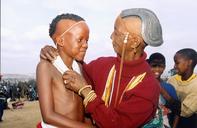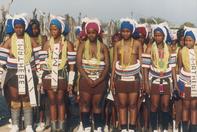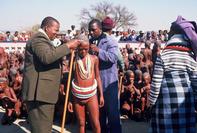Ntwana Women
The role of Ntwana women as wives and mothers is reflected in changes in the traditional dress worn at different stages of development.

Coming-out Rituals

Rites of passage, such as coming-out rituals, weddings and burials, are performed in the yards of homesteads. Before the initiation ceremonies (byale) which form part of the koma (the entire initiation period), adolescent girls undergo a puberty rite. This is a private ceremony, as Ntwana girls are accorded official group status only after initiation.
During initiation, like male initiates, they are in a state of transition — neither children nor adults. During this period, when they are vulnerable to destructive forces, they are kept in seclusion. When a young girl begins to menstruate she is secluded for several days. She is then given a leather foreskirt (lebole) sparsely decorated with rows of buttons and swaying leather tassels, signifying a new phase in her evolution from child to woman. She also wears an ntepana, a smaller version of a married woman's rear apron.
Like the foreskirt, it is usually adorned only with buttons and loose swinging vertical strings of beads similar to those found on the rear aprons of married women. The byale is directed by the chief's principal wife, older women and initiated girls. The process includes ritual hair cutting, in which the girls' hair is shaped like a bicycle seat (tlhotshwana) and rubbed with charcoal and fat, while their faces are made up with fat and red ochre. The girls are given leather aprons by their mothers which they wear with an ntepana.
Their breasts are uncovered, their arms laden with grass bangles (ditokwa) and they wear beads (mathala) around their necks. After their initial breaking-in period the initiates spend a month in a lodge (mphato) where they receive sexual and domestic instruction. They undergo a simulated circumcision and the stretching of the labia minora.
This stage is characterized by nocturnal singing and dancing, reinforcing the bonds between the initiates. They are taught how to make fertility dolls (gimwane or popenyane) and mats from river grass (legolo) and to decorate domestic calabashes (mogope). At the final stage of their initiation, the girls are called boramaswaile, and are covered with ash before returning home where they are accorded the status of kgarebe.
Ntwana Boys

For Ntwana boys, the initiation process — like that endured by their female counterparts — underscores their transitional status and also prepares them for their future role in society.
Newly circumcised males are dressed in female gear and their hair is styled in the bicycle seat design of female initiates. Round their waists they wear beaded grass hoops arranged in the order of white, red and black or blue, followed by pink — approximating the colour arrangements worn by both initiated and married women. After initiation, Ntwana men shed all signs of androgyny and assume strictly demarcated, defined social roles.